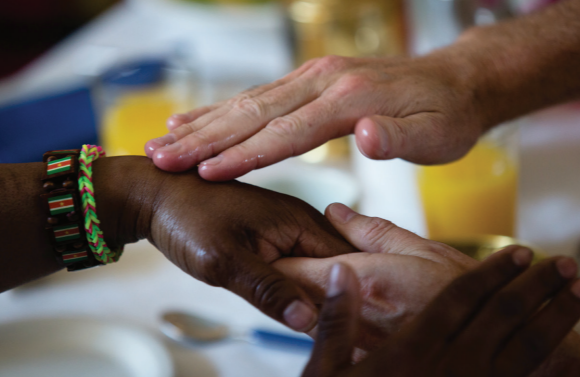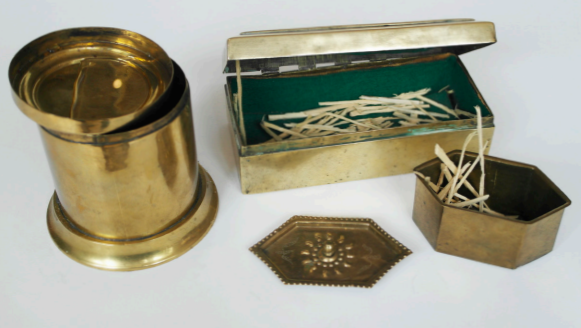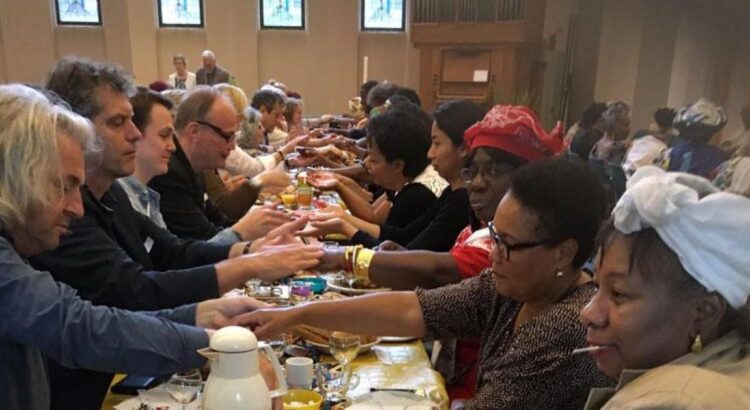It is already dark when I step into this beautiful gothic church in Amsterdam. Under the big bows of the church, an intimate table is set. It is graced with bright colored tablecloths and different sorts of Surinamese food. Tonight I will dine at a Keti Koti Table.*
The history of the Keti Koti Table
Before this evening I wasn’t familiar with the concept of the ‘Keti Koti Table’. Mercedes Zandwijken, the hostess of the evening, tells me she created it almost 15 years ago after she joined her Jewish husband Machiel Keestra at Seder night. At this night Jews all over the world will celebrate and commemorate the liberation of the Jewish people from slavery in Egypt about two thousand years ago. This is done by several ancient rituals, texts from the Tenach, symbolic acts, and a lot of conversation. Mercedes felt inspired by the way the Jewish community commemorated the past.
She decided to create a ritual to commemorate her past. Mercedes’s parents were both from Surinamese-Dutch descent and her grandmother was born into slavery. As she grew older she noticed that her past still played a big role in today’s society. She states:
“I felt an increasing need to pause and reflect on that history as it became also more evident for me that this past still makes itself felt in much of what happens in the Dutch society as a whole and in the African-Dutch community more in particular.”[1]
For this reason, she decided to create a night based on different traditions. The Seder table, along with the Ramadan festival, the Afro-American Kwanzaa festival, and the Dutch ‘dialogue tables’ that were created after the murder of Theo van Gogh, formed the basis of The Keti Koti Table. During this night everyone will dine at this table while celebrating freedom as well as commemorate slavery. It is also a way for people to share their own past and ideas. This is done by performing several rituals during the dinner. In this way, people have a moment to really think about the past and future.

The rise of the dialogue table
Since the start of the so-called ‘dialogue tables’, more than 12.000 people across the country have shared a meal together at a Keti Koti Table. The national knowledge institute Movisie chose Keti Koti Table as the best example of an anti-racism policy in 2018. They chose the initiative because the meetings created more understanding and solidarity with the participants. Mercedes and her husband Machiel were invited by different institutions on several occasions to organize a table. They play a big role during the annual Keti Koti, the day we celebrate and commemorate the end of slavery. They also held Keti-Koti tables at universities, libraries, governmental and cultural institutions. Every Keti Koti Table has a theme or a central question. During the night I am sitting at the table the discussion is more on cultural institutions and how they can be more inclusive.
How it’s done
There are people from different cultural institutions, universities, and fields of interest present. I noticed that the seating at the table is done in a special way. People from different backgrounds, color, sexes, and ages are seated across from each other. In this way, people can talk to someone who probably has a different way of seeing things or has a different history. After everyone is seated (there is 1,5 meters between every chair), the night begins with a short introduction by Mercedes. We are then asked to chew on a Kwasi Bita, a bitter kind of wood from Surinam. This way the participants taste the bitterness of the history of slavery. Normally a special quire will sing songs about slavery, but due to corona, it is completely silent instead. After people are done chewing and disinfecting their hands, we are asked to take the wrist of the person sitting across from us and rub coconut oil on it. At first, this feels a bit strange to do this to a person you’ve never met before. But it actually creates some sort of bond that makes talking about a difficult past a lot easier.
For the second portion of the evening, we get several questions from Mercedes and her husband Machiel. The main question of the night is ‘How do you open up?’. The different questions are about someone’s personal past and how it still plays a role today. The person across the table will be my dialogue partner. Every time we get a question from Mercedes we get one minute to think about it. After that minute, the first speaker gets three minutes to answer the question. The listener then gets one minute to think about the answer of the speaker, and then two minutes to answer. The process is then repeated for the second speaker. It greatly differs from a normal way of conversation. Because of my academic background, I am used to answering questions very quickly and rate criticality. Now, I have the time to really let the question sink in before I get the chance to answer. It makes the conversation more thoughtful and personal. During the questions, a special meal was served. It consists of several items such as banana, vegetables, and bakkeljauw (a kind of fish). This meal is a replica of the supper enslaved people ate at the plantations. They also serve ginger beer, this is a traditional celebratory drink from Surinam. Afterward, there is desert and time to talk freely.

The need for a personal conversation
Machiel, also a professor of philosophy at the University of Amsterdam, thinks that we as a society need to connect on a more personal level on delicate matters such as racism. “You notice that conversations about racism and inclusivity are becoming more present in today’s social debate. because these conversations get heated very quickly people get more polarized on matters such as Zwarte Piet, Black Lives Matter, and the history of slavery. Our vision is that when you get people to talk on a personal level, this will lead to a greater understanding of one another.” This will also lead to a greater understanding of bigger issues in our society. You create more understanding and empathy.”
I can imagine this is also helpful when it comes to cultural institutions, the focus of the night. Many institutions want to create stories from a personal perspective, the understanding of someone’s history is crucial in this process. The Keti Koti Table creates a safe environment for these institutions to think and talk about matters such as inclusivity, alternative history, personal stories, and the history of slavery.
I leave the church with a satisfying feeling. The intimate setting and the rituals make you feel comfortable to share personal stories with someone you’ve never met. The Keti Koti Table is a great way of using the past for understanding each other today.
*Because of the sensitive nature of this event I was asked not to put in names or stories of the participants or participating institutions.
Story by Daimy Comijs
[1] Keestra, M & Zandwijken, M., A Tori: manual of The Keti Koti Table. (September, 2018) 7.
